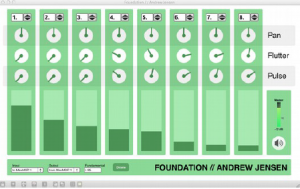Andrew Jensen and Dr. Steven Ricks, Music
Introduction
The harmonic series is one of the most fundamental or foundational elements of musical harmony. The relationships between elements in this series explain why certain chords appeal to the human ear while others do not. My ORCA project involved creating a software synthesizer that uses the tones in the harmonic series to create improvised electronic music on a laptop computer. I performed in concert with the instrument at the Utah CrossTalk concert at the University of Utah on December 3, 2013. I copied the source code onto the computer in BYU’s Electronic Music Studio for composition faculty and students to use. I also released the source code publicly on the internet.
Creating the Foundation Synth
My faculty mentor was Dr. Steven Ricks from the music department. We corresponded over several months and I developed a Max/MSP patch that I called the Foundation Synth. The synthesizer contains eight sine wave oscillators, each with volume control, pan, and amplitude modulation. Each of these oscillators is tuned to a partial on the harmonic series, based on a single fundamental frequency. The default frequency is 55Hz (exactly 3 octaves below A-440) but may be changed. This method of tuning makes the synthesizer quite different from conventional synthesizers, both hardware- and software-based.
After the first version of the synth was created, Dr. Ricks and I spent a lot of time discussing ways to make it easier to play in a live performance context. I programmed the synth to respond to input from the Korg NanoKontrol 2 MIDI interface. This made it easier and more natural to manipulate in a live setting. Dr. Ricks modified the patch to respond to his M-Audio Trigger Finger MIDI interface. After realizing that the interface on the synthesizer was a little clumsy for playing quick passages, I altered the design to have a “drone mode” for slower soundscapes and an “instrument mode” where button and key presses would quickly change parameters like volume and pitch.
Performing at CrossTalk
Dr. Ricks and I performed on the Foundation Synth at the Utah CrossTalk concert at The University of Utah on Tuesday, December 3. The CrossTalk concert is an event that showcases electronic music compositions by BYU and U of U students. The majority of the pieces at the concert tend to be pre-recorded tape music, so my performance stood out as one of the few live electronic pieces. My laptop’s screen was projected onto a screen during the performance, so the audience was able to see my manipulation of the Foundation Synth.
The piece itself was an eight-minute structured improvisation: there were pre-determined sections in the piece but the notes themselves were not dictated by a score. The piece began on a low drone on A-55 and grew to include the first eight partials in the harmonic series. The audio output from my laptop was panned to the right side of the room and Dr. Ricks’ output was panned to the left side. A section of call-and-response followed, and then a section of short solos. While I played a solo, Dr. Ricks slowly built up the droning texture, and as he soloed, I did the same. The volume and complexity of the soundscape slowly rose to a climax. Then we brought the sound back down to a single drone on A-55 and faded out.
Distributing the Source Code
Performing with the synthesizer was a good opportunity to demonstrate its versatility, but I believe that it can be used in many contexts besides live performance. The Foundation Synth could be placed in a museum room with a small display and a set of surround sound speakers, for example, and non-musicians would be able to appreciate the harmonic series more by experimenting with the synth. Because there are so many ways to use the synthesizer, I would like as many people to see it as possible, and for that reason, I have released the source code through two different channels.
On Wednesday, December 11, I met in the BYU Electronic Music Studio with a composition class taught by Dr. Neil Thornock. I presented the synthesizer and showed the inner workings to the class for about 10 minutes. I also copied the source code onto the computer in the EMS, so the students could use it in the future. Unfortunately, the audio output from Max/MSP to the EMS speakers was not properly configured, so I could not demonstrate what the synthesizer sounded like, but Dr. Thornock told the class that he would have a TA configure the sound so they could experiment with it later.
I also published the source code to the synthesizer publicly on GitHub.com. This makes the synthesizer visible to search engines and people that are interested in electronic music and the harmonic series. Since the code is stored on GitHub, other people who would like to contribute to improving the synthesizer in the future can download the code and issue a “pull request” – a request for me to combine their changes in with the original code I have created. The URL for the synthesizer’s source code repository is https://github.com/andrewjensen/foundation-synth.
Conclusion
My ORCA project was an excellent opportunity for studying the harmonic series, collaborating with Dr. Ricks, and creating software for the composition department. I would like to thank the Office of Research and Creative Activities for this opportunity and hope that many other students will have similarly good experiences with the ORCA program.

Figure 1: Screenshot of the Foundation Synth – Eight columns can be seen, representing eight sine wave oscillators. The number at the top of each column changes the partial of the oscillators, while the three knobs control stereo pan, flutter (AM speed), and pulse (AM depth). The dark green fader on each column controls the volume of the oscillators.
